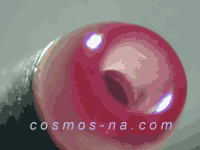

Coil Winding Nozzles - Ruby Tipped
Air Wipes
Bow Guides
Carbide Guides
Eyelet Guides
Nozzle Guides
Pulleys
Ring Guides
Rods
Roller Guides
Snail Guides
Tube Guides
U- Guides
Welding Butts
Surface Finish
Glossary
Inquiry Forms
Materials
Site Map

Ruby and Sapphire are the hardest among the materials selected for coil winding nozzle entrance and exit. Their single crystal (mono crystalline) structure allows diamond polishing to a mirror finish unmatched by other material, reducing friction and protecting the wire. Shown at left is a photomicrograph of a ruby exit orifice.
Technical Data
Hardness value: 1,800 – 2,200 Vickers, or 3 times that of case hardened steel
Surface roughness: 0.025 – 0.05 microns, or 1 – 2 micro inches Ra
Tip I. D. Choice of Ø 0.3, 0.5, 0.6, 0.7, 0.8, 1.0, 1.2, 1.4, 1.8 mm
Outside diameter: 0.5 – 4.0 mm, wall thickness governing
Length: 10 – 50 mm, aspect ratio governing
Young's modulus: 190 - 210 MPa
Issues with Ruby Tipped Nozzle
The body of a ruby tipped nozzle is usually made of a stainless steel tube that retains the longitudinal grains inherent to all hard drawn steel tubes, which will form a bulge in the bore when bent then straightened. Upon impact, the ruby tip either will be broken or fractured which may not be visible to the naked eyes but which nevertheless will damage the wire. Therefore, a ruby nozzle after impact should be discarded.
Part Numbers
A 2-section ruby nozzle can best be described by our coil winding nozzle numbering system. A 3-section ruby nozzle needs a dedicated dimensional drawing, of which one representative drawing is depicted in our coil winding nozzle drawings
Introduction Tungsten Carbide The Numbering System The Drawings Product Gallery ( 1 )